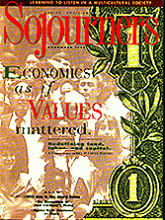Last month this magazine ran a couple of articles on consumerism and mall culture. The pieces were hooked to the advent of the double-super-monster "Mall of America" in Minnesota and to the kudzu-like spread of Wal-Marts, Sam's Clubs, and other Walton family enterprises.
I read these with great interest, because, while I've never been to the Mall of America, I can honestly say that I've never met a mall I didn't like. I don't buy much at the mall. But it's a great place to walk around and sit and drink one Coca-Cola for an hour or so. I especially love malls in the summertime because they are always so well air-conditioned, and my home is so often not. I suspect that a similar climatic impulse, in reverse, feeds the Mall of America's appeal.
But if I love the mall, I need the Wal-Mart. We really do buy stuff at Wal-Mart. And I love Wal-Mart culture. I like the old guy who stands at the door and says, "Hi," when you walk in. At Wal-Mart I can afford two, what the hey, three cokes per trip from those Sam's Choice vending machines. They're only 20 cents a pop.
But that wasn't the point of the articles in question. Their point was that consumerism, that is, an excessive devotion to the accumulation of stuff, is spiritually destructive and that huge-scale enterprises like mega-malls and Wal-Marts are dehumanizing and destructive of community.
Read the Full Article

